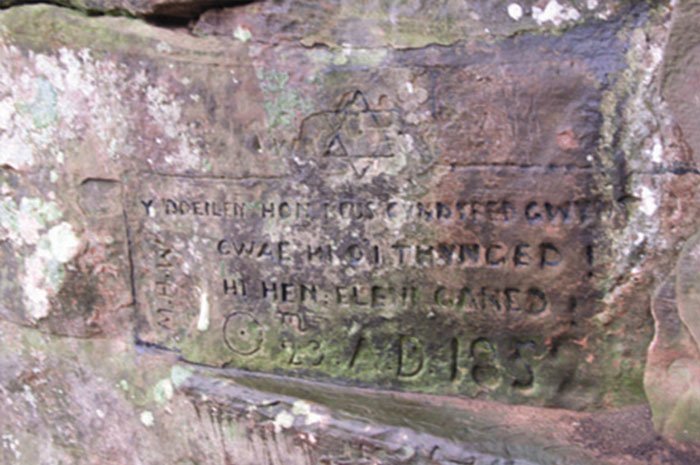The presence of Roman graffiti in the sandstone of the riverbank nearby could indicate that they were excavated before the Romans came to quarry sandstone, and ferry it downriver to Stanwix for the construction of the wall and fort.
Difficult to find even now, the cells were probably improved by the monks of the Priory and used for the storage of emergency food or their valuables in troubled times.

Title pic: Cell engraving Luke Clennel 1814 (Courtesy Carlisle Library). Above: Cell entrance.
There is a fireplace in the front wall overlooking the river, which suggests that they were also used as a refuge for the monks against Border raiders.
The Roman inscription on the riverbank near the cells has been known for many years. Unfortunately in 1991, due to erosion, the rock carrying part of the inscription came loose and fell down the riverbank, so the National Trust removed it for safe keeping. It is now in Tullie House Museum.
The inscription (in Latin) reads “Maximus wrote this” and the second part (still in situo) reads “Condrausisius of the Twentieth Legion Valerie Victrix.” Victorian graffiti (also in Latin) is found close to the Wetheral Cells.

Gulielmus (William) Mounsey
The first example can be seen in the rock face halfway down the steps to the cells. The main text is a verse from the songs of Llywarch Hen, a Welsh poet of the early 9th century. It translates: “This leaf which is being persecuted by the wind, let her beware of her fate: She is old though only born this year”.
A second inscription, about 20 metres downstream from the first, reads:
To meet the Atlantic’s
boundless time, See old
Ituna’s waters glide, As
rolls the river to the sea,
So time unto eternity.O mVo AD 1852
YESNUOM SUMLEILVG
The signature at the bottom is Gulielmus (William) Mounsey written backwards and Ituna is the Roman name for the River Eden. William Mounsey, who liked to show off his classical education, was one of the Mounsey’s of Castletown, Rockliffe. He walked the whole length of the Eden from Rockliffe to Mallerstang leaving his mark on various sandstone outcrops.
Written by David Ramshaw
More historical information about Wetheral Priory and Wetheral Woods can be found in Wetheral and Great Corby – a local history, by Denis Perriam and David Ramshaw.






